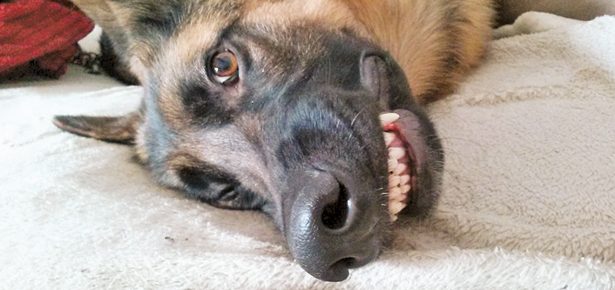

Canine Degenerative Myelopathy Explained
Understanding the disease
Degenerative myelopathy is a degenerative disease of the spinal cord that begins in older adulthood and progresses slowly until dogs are no longer able to walk unassisted. The cause of the disease is associated with a mutation in the SOD1 gene. It is not known exactly how the mutation of this gene leads to degeneration of the spinal cord in dogs, but the disease does interfere with the brain’s communication to the limbs, resulting in difficulty walking.
Dr. Beth Boudreau, clinical assistant professor at the Texas A&M College of Veterinary Medicine & Biomedical Sciences, further explained the disease. “In degenerative myelopathy, the pathways that carry neural information in the spinal cord lose their insulatory coating and begin to fragment, and eventually the neurons that produce those signals also begin to die,” she said. “This results in a loss of motor control that begins in the hind limbs, but can spread to involve the front limbs as well as the pathways that control breathing, urination, and defecation. Currently, these changes are irreversible. Advanced cases may cause difficulty breathing as well. The disease is considered to be eventually fatal.”
The signs of degenerative myelopathy often begin around eight to nine years of age in larger breeds, and small breeds may have a later onset of signs around eleven years of age. Initially, mild stumbling, weakness, or incoordination of the hind limbs may be apparent. Although both hind limbs are usually affected, one is often weaker than the other. The signs slowly progress over a period of weeks to months and the disease does not cause the dog any apparent pain.
Testing for the associated mutation is an important part of the diagnosis of degenerative myelopathy. However, some dogs that have this mutation may never develop the disease, so a positive result of the genetic test alone cannot be relied upon for diagnosis. Additionally, other health conditions may share similar signs of degenerative myelopathy.
“Compared to other common causes of chronic spinal cord injury in older dogs, degenerative myelopathy often has a slower onset and progression, and it is not painful,” Boudreau said. “However, other spinal cord diseases, such as chronic intervertebral disc herniation, and even some tumors, may appear clinically similar. A complete evaluation with diagnostics and performed by a neurologist is recommended to rule out diseases that can mimic degenerative myelopathy.”
Currently, there is no known effective medical or surgical treatment for degenerative myelopathy. However, physical rehabilitation therapy at veterinary clinics has been shown to result in longer survival times for dogs affected by the disease.
“Unfortunately, this disease progresses, with most dogs becoming unable to walk within six to nine months after the first signs appear,” Boudreau said. “Because this condition does not appear to be painful, many dogs can continue to have a good quality of life even after they become unable to walk, if provided good supportive care. Dogs that cannot walk will need an assistance device, such as a cart or harness, to help them move about.”
Additionally, severely affected dogs may need assistance to void their bladders. Regular passive exercise of the limbs, turning, and cleaning are needed to prevent limb contractures and bedsores. Although many dogs tolerate the necessary nursing care very well, it is important for owners of dogs with degenerative myelopathy to regularly communicate with their veterinarian and assess their pet’s quality of life.
Join the newsletter and never miss out on dog content again!
"*" indicates required fields
By clicking the arrow, you agree to our web Terms of Use and Privacy & Cookie Policy. Easy unsubscribe links are provided in every email.





